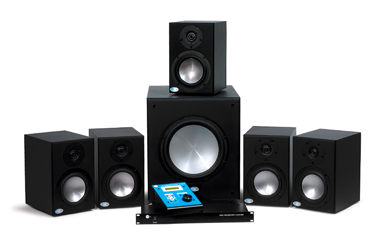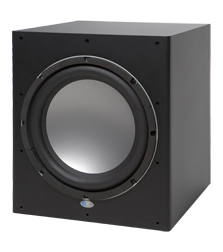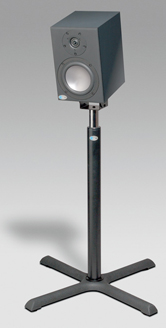Confusion: LFE, Subwoofer & Bass-Management?
July 4, 2008
When talking to people about 5.1 audio, one of the more common problems in helping people understand certain concepts, is the confusion involving some of the basic terminology.
What is the .1 / LFE Channel and why does it exist?
The .1 or LFE is a channel which is exclusively used for frequencies below 120Hz (below 80Hz for DTS). It is therefore a bandwidth limited channel, but it is not the same as the subwoofer, which is the speaker that typically reproduces the LFE channel in a home audio or studio monitoring system (more information is provided below). The purpose of this channel is to provide an additional 10dB of electrical headroom, for low frequencies, above the main channels. This is done by calibrating the acoustic playback level, so that it has 10dB of in-band gain above the other channels (fronts and surrounds).
Why are TV commercials so loud?
June 5, 2008
As an avid audio / video enthusiast, my friends and family will often contact me when they have a question about their home AV system. One of the most common questions I get, is regarding the relative inconsistency in audio level between different TV programs, channels and in particular commercials. The complaint about TV commercials has been around for a long time, but with the advent of HDTV and digital broadcast television, new technologies are available to the content creators and broadcasters which are designed to mitigate the severity of these differences in level. Unfortunately, even with HDTV and digital broadcast television, the problem hasn’t improved much and in some cases it seems to have gotten worse.
The reasons for the lack of improvement are complex and often vary depending on the content creator, broadcast network and even differences between national and local broadcast networks. To help understand what is causing these ‘issues’, it is probably best to first review one of the key technologies that is available today, to help mitigate this problem. Dolby Digital, which is currently used as the preferred audio delivery format for many HDTV broadcasts, includes several unique features which are designed to help improve consistency between various broadcasts and other audio sources.
Evolution & The Art of Speaker Design
May 17, 2008

This article was also published in the October 2001 edition of Pro Sound News. You can download a PDF copy by following this link to the Blue Sky website (130KB Adobe Acrobat PDF).
Through the ages, science and art have always been closely linked. These days people have forgotten how much individual artistic talent goes into truly magnificently engineered products. An example of a product that requires a considerable amount of technical and artistic talent is an accurate studio monitor. This article will show how a new technology, known as BOO®, can bring artistic vision and ideal acoustic performance to the marketplace more quickly and take out much of the guesswork.
Designing a modern loudspeaker involves many factors, including: Output requirements, room acoustics, directivity requirements, psychoacoustics (how people perceive sound), and design philosophy. Design philosophy can also be interpreted as the artistic vision for a product. Artistic vision / design philosophy is typically made up of the factors, that a company or engineer has discovered through research and experience, which make a speaker sound “goodâ€.  For Blue Sky International these factors usually include such things as smooth on & off axis frequency response, flat on axis response, a wide listening window, and meeting a certain output requirement.
Design Philosophy: Blue Sky Studio Monitors
May 17, 2008
This article was also published in the October 2006 edition of Resolution Magazine. You can download a PDF copy by following this link to the Blue Sky website (143KB Adobe Acrobat PDF).
Intro
About 8 years ago, my business partners at Blue Sky and I had a number of meetings to discuss designing a new series of studio monitors. After much debate, we decided there was little point in building another set of “me too†monitors, in the typical 5â€, 6†and 8†2-way configurations. What we felt was needed was a different approach that overcame some of the limitations of current monitors and provided tangible real world benefits to the recording engineer.
So where did we begin?
When creating the requirements for Blue Sky’s nearfield and mid-field studio monitors, we decided to start at the end of the chain and work backwards to the beginning.
Acoustics: A guide to online resources
May 12, 2008
The single biggest factor impacting the performance of your home audio speakers or studio monitors, is the acoustics of the room or studio they are placed in. Recognizing this, over the last few years there has been a tremendous growth in the number of companies offering acoustic treatment products, along with providing extensive technical information. Below is a short overview of the biggest factors impacting home theater and studio acoustics, along with links to companies that offer products and technical resources which may assist you in addressing these issues.
More »
Professional Studio Monitoring System Calibration
May 9, 2008
The Instructions:
Instructions for electro-acoustic calibration of a professional stereo, 2.1 and 5.1 studio monitoring systems (speakers) using a SPL meter and ADL’s test files. If you are interested in calibrating a home theater system, we recommend using the test signals and procedures included with your home theater receiver.
Before starting, download the ADLTestFiles.zip (15 MB). To download the zip file, “Right Click†and select “Save Target As†and the file will begin downloading.
Once downloaded, either burn the test files on to a CD or import them directly into your DAW and follow the instructions below.
Subwoofer Placement
May 9, 2008
Today, many consumer and professional monitoring systems incorporate a subwoofer as an integral part of the system. Making the subwoofer an integral part of the monitoring system design relieves the satellite speakers of the requirement to reproduce low frequencies. Smaller satellite speakers are more easily placed for the best imaging and the sub can be positioned for the best bass response.
But what is the best location for your subwoofer?
Overview
The low frequency response and efficiency of a subwoofer are heavily influenced by the acoustics of the playback environment. More specifically, the response is influenced by the room’s dimensional ratios, types of construction and location of the subwoofer within that environment. You can significantly improve the subwoofer’s in-room response and efficiency by experimenting with various room placements until you find an optimum location.
Stereo and Surround Speaker Placement
May 9, 2008
Proper placement and aiming of the speakers in your studio or home audio system, can greatly improve the audio experience. Below are suggestions for placement of speakers for three general applications; stereo, 5.1 music and 5.1 film. If at all possible, speaker placement should be symmetrical relative to the room boundaries and the listening position.
Suggested Guidelines For Stereo Monitoring Placement
The recommended position for the left and right speakers, in a stereo configuration, is at a 60 degree angle relative to the listener, forming an equilateral triangle (a triangle with equal sides) as shown in the Reference Monitoring Position diagram (click to view). Fortunately, this setup eliminates most of the math and is easily simplified to the following guidelines: If you want to sit 1 meter (39.37 inches) from the speakers, place the speakers 1 meter apart. If you want to sit 6 ft from the speakers, place the speakers 6 ft apart. Etc.
Ideally the speakers should be at seated ear height as show in the Monitoring Height Recommendation (click to view). If this is not possible, tilting the speaker cabinet at the listening area can improve high-frequency coverage.





